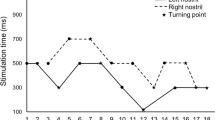Abstract
Objective: The principal objective was to chart sensitivity for human nasal irritation by alternative psychophysical methods, namely, a common detection procedure versus a nasal lateralization procedure that required the subject to indicate whether a vapor had stimulated the left or right nostril. This objective relates to the broader issues as to (a) whether subjects with normal olfaction (normosmics) can yield, through novel methodology, an index of sensitivity to nasal irritation comparable with that obtained from subjects without olfaction (anosmics) and (b) whether both types of subjects have similar irritation sensitivity in general. This study sought to gauge interconvertability both between types of subjects and between modes of stimulus presentation for irritative and, where appropriate, olfactory stimulation.
Methods: Static dilution series of four n-aliphatic alcohols, chosen to represent volatile organic compounds (VOCs), provided the source of calibrated olfactory and irritative vapors emitted from their squeezable containers into the nose or eye either by a mechanical device or by hand. Standard psychophysical methodology (forced-choice; ascending strength of stimulation) served to chart detection thresholds for irritation and odor and an analogous procedure served to chart the threshold for localization of stimulation.
Results: Within the limits of resolution, detection thresholds and nasal localization thresholds yielded comparable indices of the potency of the VOCs to evoke nasal irritation. The thresholds agreed well with those for detection of eye irritation, though only the eyes proved to be capable of detecting irritation from 1-octanol. The method of emitting the stimulus had little material effect on measures of either irritative or olfactory detection.
Conclusions: The threshold for nasal localization offers a suitable way to measure nasal irritation in normosmic persons. Olfactory stimulation does not interfere with the measure since subjects cannot localize on that basis. Anosmic and normosmic persons have comparable sensitivity to nasal and ocular irritation. If anosmic persons have any lower sensitivity, as sometimes claimed, it would seem to have only trivial consequences for estimates of the irritative potency of VOCs.
Similar content being viewed by others
Author information
Authors and Affiliations
Additional information
Received: 10 April 1997 / Accepted: 10 July 1997
Rights and permissions
About this article
Cite this article
Cometto-Muñiz, J., Cain, W. Trigeminal and olfactory sensitivity: comparison of modalities and methods of measurement. Int Arch Occup Environ Health 71, 105–110 (1998). https://doi.org/10.1007/s004200050256
Issue Date:
DOI: https://doi.org/10.1007/s004200050256




